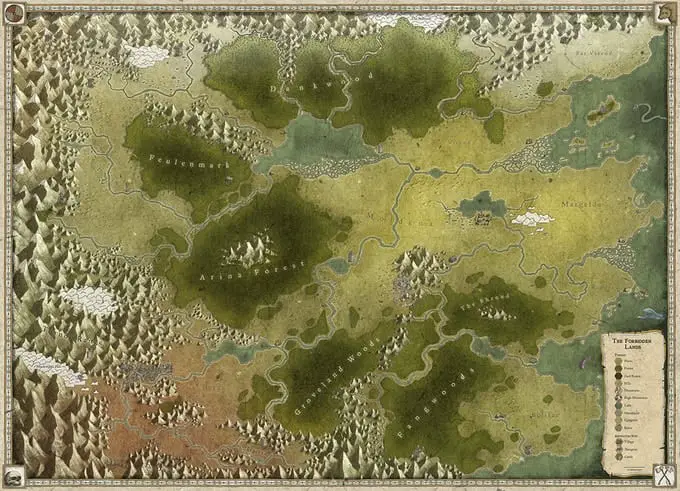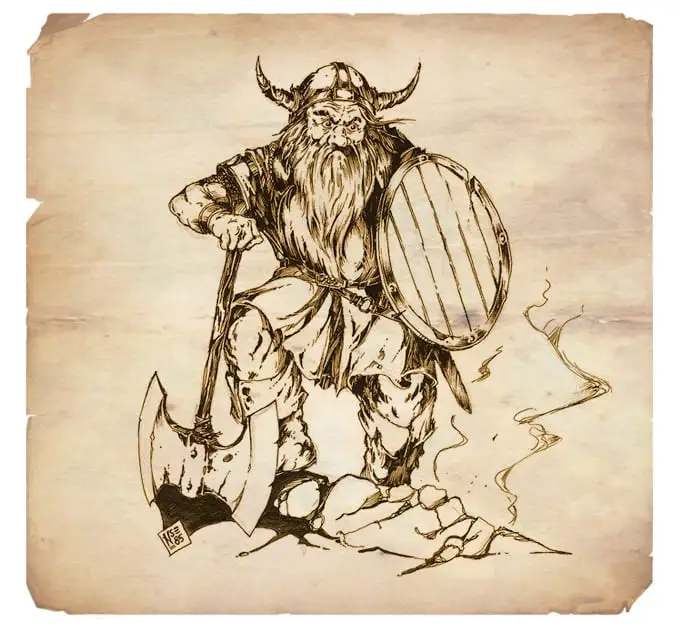Free League Publishing is a company that somehow missed me until this past year, when I encountered them at GenCon showing off their Crusader Kings board game with Paradox. They were nice enough, though, to send me review materials for their hit RPG’s like Mutant Year Zero, Tales from the Loop, and Coriolis, all of which I’ll have reviews and info on very soon. But the first RPG I wanted to cover was the one they debuted at GenCon, completed a very successful Kickstarter in the fall, and finally launched on the 6th of December: Forbidden Lands. A “retro open-world survival fantasy RPG,” Forbidden Lands was developed with an all-star group of Swedish talent, including art from Nils Gulliksson and Simon Stålenhag, and lore by author Erik Granström (Svalvelvinter, Vanderland) and uses the d6 based system common to all of Free League’s games. So that’s the facts of the game, but what is it really like? Guard yourselves against the bloodmist and prepare yourself for a dark tale, as we enter the harsh world of the Forbidden Lands.
Enter The Raven Lands

Like any good sword and sorcery tale, the world of Forbidden Lands is nasty and brutish, awash with fantastic monsters and evil sorcerers. What makes it a little different from other Conan-esque games is that there’s an almost post-apocalyptic quality to the lands you’re adventuring in. This isn’t a land in some bizarre primordial stone age, this is a land post-fall. The gods are either dead or have abandoned the world, the great cities have fallen, and war, demonic invasions, war, and the mysterious and carnivorous Blood Mist have all taken their toll. But things have quieted down by the time the players enter Alderland, and its a world ready to rebuild.
What all this means in functional terms is that Forbidden Lands is an incredibly freeing game when it comes to direction for players. While they do have some existing hooks and stories, one of which I used for my sessions, it is incredibly easy for a GM and their players to write their own stories within the world. The limitations that Forbidden Lands places on the world actually go a long way towards helping players feel like they’re really making a difference. This deep history also allows for a heavy use of legends and folktales as backstory for nearly every element of the world, and there’s a great deal of support for DM’s to assign any random rock, ruin, or tree a connection to some long lost god or hero.
The world of Alderland is also incredibly refreshing in that it doesn’t use it’s world as a crutch to be gross. So many “dark” settings, even going back to Howard himself, like to use things like rape as shorthand for how bad the world is. For all the time I spent reading through the books, and the sessions I ran, there was never really a point where the world felt edgy. It’s violent, harsh, and unforgiving, yes, but it’s not grimdark. There’s no heroes, but that doesn’t mean you’re playing absolute monsters either.
No Heroes Allowed

On that note, I’d like to talk a little bit about the “heroes” of Forbidden Lands, or lack thereof, and that’s the characters and their creation. Like a lot of modern games, the idea of the “hero” has largely been done away with, and the player characters of Forbidden Lands are all anti-heroes, out only to make money and not die in the unforgiving wilderness. While they might stumble into being helpful now and then, the players are mostly just out for themselves. There aren’t really alignments in the game, which means players and GM are able to experiment with their reactions and shape a much more three-dimensional character. Free League has applied “sandbox” to even character creation.
Kin
Races in Forbidden Lands differ from other sword-and-sorcery games in that they largely follow the standard fantasy racial makeup i.e elves, dwarves, humans, halflings etc. They each have a little twist to them that rubs a bit of schmutz on the set in stone archetypes most gamers have come to know. Halflings, for instance, are much more blatantly Hobbits, down to their shiny buttons and woolly feet. But the halflings of Alderland live in what is essentially The Stepford Wives, with everyone smiling and playing friendly even as their communities deteriorate. Things like abuse, alcoholism, or insanity are all covered up so the Halflings can maintain that idyllic Shire-like innocence they’re normally associated with. Goblins, on the other hand, are as nasty and impish as always, but also much more noble than usual. They act as wardens and protectors, doing the dirty work to protect the more “civilized” races from the beasts of the wild. And Half-elves, usually subject to racism and rejection by their two halves, are instead greater than the sum of their parts, acting haughty and proud around both elves and men as they are driven by their feelings of superiority to make their mark on the world.
Professions

Professions are the game’s version of classes, and again tend to follow the usual mold. A couple interesting new classes were added however: The Rider, The Minstrel, and the Peddler. The Rider is a horse-based class that draws more on Mongolian riders than medieval knights, as it puts emphasis more on maneuverability and bow work than front-line charges. The Minstrel is, naturally, the Bard equivalent, but with a clear emphasis on healing rather than the weird mix of magics traditionally given to bards. They retain their role as “faces” of the party, but that isn’t quite as essential in a world of mostly rocks and monsters. Finally, the Peddler is perhaps the oddest choice of profession in the base rulebook, based simply on the fact that on its face it doesn’t seem like it’d be well suited for adventuring. But the profession offers a very cool amount of utility for the party, thanks to their ability to produce seemingly anything at will, sniff out wealth, and even charm people out of attacking you. Outside of base rules and talents, though, the Profession you pick is pretty open ended like the rest of the game.
Adventuring

Forbidden Lands was the first RPG I played that used the d6 based system common to Free League’s games. Essentially, each roll is done with a pool of d6’s instead of one of the myriad multi-sided dice you use in D&D, with special dice for skill rolls and for weapon rolls. You only need one six to succeed, but none means failure. That’s where the other big part of the rolling system comes in: pushing. That is when a player, who’s failed a roll, tries again by rolling all of the dice that weren’t sixes or ones (or swords and skulls if using the special Forbidden Lands dice). While you get another chance to succeed, the ones start to affect you when you push. The more you roll, the more damage to you or your weapon occur. You also get only one chance at any roll. Just one. So if you try to climb a mountain and fall, you gotta find another way up the mountain. This makes pushing essential, which goes double for magic users.
Magic users are a lot less over the top than in D&D and other systems. While they are able to pull off very impressive feats, they can only do so by spending Willpower points, which they only get from pushing. So there is always a risk that goes a long with reward. This risk and reward mentality is furthered when rolling for spells, as any ones rolled lead to effects that do everything from inducing hunger to getting the spell-caster abducted by demons. And that will happen, as this is a hard, hard, game. You are going to die, something that the book spells out very early. Even the smallest slip up can lead to a painful demise for your character (none of my players survived the sessions we played).
The Verdict

Forbidden Lands is a total breath of fresh air in the current RPG landscape. The flexibility given to all parties, the engaging world, and tense action all combine to create an incredibly fun experience for everyone involved. It’s a bit cliche at this point, but there is definitely a Dark Souls quality to Forbidden Lands, especially in its approach to punishing difficulty and satisfying wins. Plus, the presentation is absolutely top notch. While I’ll have more on that when I receive the hardcopies, the internal art and writing of the core rulebooks is deeply immersive. You feel, at times, like you’re reading a tome of ancient knowledge as opposed to a splat book. The sandbox nature of it also means that it’s very easy for new players to jump in, and it can more easily be dropped and picked up than more rule-intensive RPG’s.
The only thing that might hang this up is that it’s not necessarily friendly for people who don’t like darker settings. While a lot of games leave a ton of room for tonal flexibility, Free League set the dial on Forbidden Lands to “bleak” and ripped it off. No matter what you do, you can’t get away from the harsh and violent world that is Alderland. For those who like a more escapist adventure in their RPG’s, this might end up being a harder sell. But for those who like things a little darker, a little grittier, this is for sure something worth adding to your tabletop rotation.
![]()
![]()
![]()
![]()
The core Forbidden Lands bundle is available on Free League’s website, retailing for $45.80 plus shipping, with the bigger and beefier Raven Bundle, containing special cards, a GM screen, and the Raven’s Purge campaign, is available for $91.83 plus shipping. Thanks to Free League for the opportunity to review the game, and stay tuned to the Fandomentals for all the latest from Free League and RPG gaming.
______________________________________________________________________________________________________________________________________

